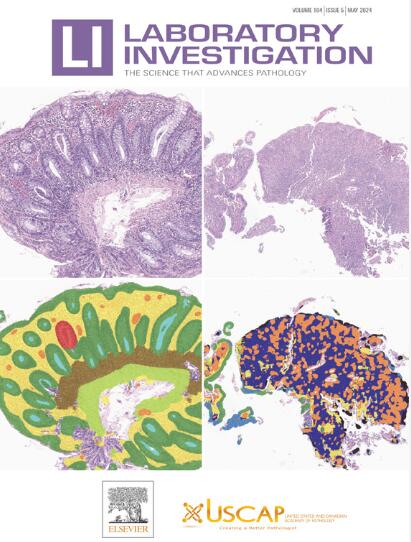SATB2 Loss Is a Sensitive Biomarker for Dysplasia in Inflammatory Bowel Disease
IF 4.2
2区 医学
Q1 MEDICINE, RESEARCH & EXPERIMENTAL
引用次数: 0
Abstract
Loss of SATB2 expression has emerged as a promising biomarker for dysplasia in inflammatory bowel disease (IBD), but its sensitivity and specificity remain unclear. We retrospectively evaluated immunohistochemical (IHC) staining of SATB2 and p53 in colorectal biopsies from 37 IBD patients (25 men and 12 women; median age: 48 years) with suspected dysplasia. The cohort included 26 ulcerative colitis (70%) and 11 Crohn’s disease (30%). Fourteen patients (38%) developed IBD-associated invasive carcinoma, and 18 (49%) had persistent dysplasia on follow-up. Histologic review identified 80 lesions initially diagnosed as negative (16%), indefinite (39%), low-grade (36%), and high-grade (9%) dysplasia. IHC revealed aberrant p53 in 35 lesions (44%) and SATB2 loss in 42 lesions (53%), with 19 (24%) showing both abnormalities. Reappraisal of diagnoses combining histology and IHC reclassified lesions into indefinite (20%), low-grade (63%), and high-grade (17%) dysplasia. Lesions with SATB2 loss alone were more frequently of lower grade (P = .003). Dysplasia types included 15 conventional dysplasia (19%) and 65 nonconventional dysplasia (81%). The rates of p53 abnormality, SATB2 loss, and their combination were similar in nonconventional dysplasia (45%, 55%, and 75%, respectively) and conventional dysplasia (40%, 47%, and 67%, respectively) and comparable between cancer patients (50%, 56%, and 74%, respectively) and noncancer patients (39%, 50%, and 72%, respectively). Missed dysplasias in cancer patients were all nonconventional, and lesions with p53 abnormality more likely progressed to cancer (P = .002). In conclusion, SATB2 loss is a sensitive marker for IBD-associated dysplasia. Combined use of SATB2 and p53 IHC improves dysplasia detection and reduces false-negative diagnosis, supporting its application into routine diagnostic practice.
SATB2缺失是炎症性肠病异常增生的敏感生物标志物
SATB2表达缺失已成为炎症性肠病(IBD)中一个很有前景的生物标志物,但其敏感性和特异性尚不清楚。我们回顾性评估了37例IBD患者(男性25例,女性12例;中位年龄:48岁),疑似发育不良。该队列包括26例溃疡性结肠炎(70%)和11例克罗恩病(30%)。14名患者(38%)发展为ibd相关的浸润性癌,18名患者(49%)在随访中出现持续的不典型增生。组织学检查确定了80个病变,最初诊断为阴性(16%)、不明确(39%)、低级别(36%)和高级别(9%)发育不良。免疫组化显示35例(44%)病变中p53异常,42例(53%)病变中SATB2缺失,其中19例(24%)病变同时显示两种异常。结合组织学和免疫组织结构重新评估诊断,将病变重新分类为不明确(20%)、低级别(63%)和高级别(17%)发育不良。单纯SATB2丢失的病变更常发生低级别病变(P = 0.003)。异常增生类型包括15例常规异常增生(19%)和65例非常规异常增生(81%)。p53异常率、SATB2丢失率及其组合在非常规异常增生(分别为45%、55%和75%)和常规异常增生(分别为40%、47%和67%)中相似,在癌症患者(分别为50%、56%和74%)和非癌症患者(分别为39%、50%和72%)中相似。肿瘤患者未发现的发育不良均为非常规性的,p53异常的病变更容易发展为癌症(P = 0.002)。综上所述,SATB2缺失是ibd相关发育不良的敏感标志物。联合使用SATB2和p53免疫组化提高了异常增生的检测,减少了假阴性诊断,支持其应用于常规诊断实践。
本文章由计算机程序翻译,如有差异,请以英文原文为准。
求助全文
约1分钟内获得全文
求助全文
来源期刊

Laboratory Investigation
医学-病理学
CiteScore
8.30
自引率
0.00%
发文量
125
审稿时长
2 months
期刊介绍:
Laboratory Investigation is an international journal owned by the United States and Canadian Academy of Pathology. Laboratory Investigation offers prompt publication of high-quality original research in all biomedical disciplines relating to the understanding of human disease and the application of new methods to the diagnosis of disease. Both human and experimental studies are welcome.
 求助内容:
求助内容: 应助结果提醒方式:
应助结果提醒方式:


